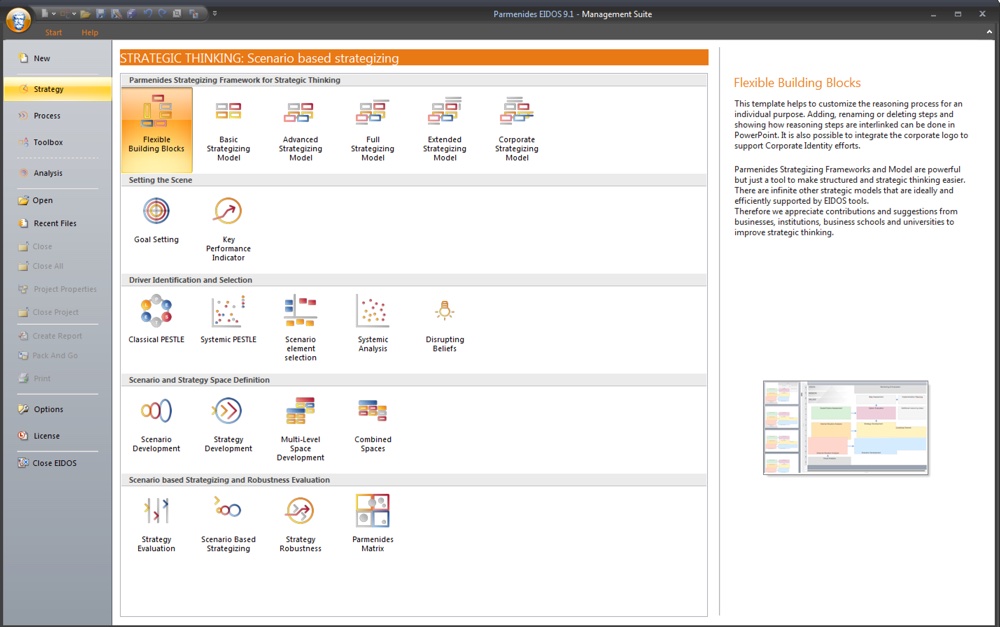The Parmenides Strategizing Model
From "one shot" to longterm, integrated, scalable strategy architectures to address corporate challenges.
The Parmenides Strategizing Model increases the efficiency of reasoning processes and the quality of decisions by structuring a problem solving, decision making or policy development process into its components. The model helps to relate the needed tool-support to the different reasoning steps.
Parmenides EIDOS Strategizing Model provides ready-to-use strategy models for delimitable, single decisions (basic model), processes integrating scenarios and strategies (advanced/full model) as well as templates for comprehensive (multi-layer) strategy architectures (extended/corporate model) and modular building blocks to flexibly design individual reasoning processes. The models help extracting and structuring the existing knowledge and expertise on complex problems in a way that relevant contributors from small teams to large audiences are integrated in a meaningful way.

Basic Strategizing Model
There is a common understanding of strategists that a strategic process consists of four basic elements: Defining objectives, analyzing the current situation, developing and evaluating options. The only dispute might evolve about the right sequence of the steps - finally there is no right or wrong. The basic strategizing model operationalizes these four generic steps to reason about complex issues. We talk about "strategizing" and "strategy" because of EIDOS' long-term adaptability – strategy becomes a continuous exercise in which new findings or unexpected events can be integrated seamlessly into the reasoning process. The basic strategizing model constitutes a robust, easy to apply process for delimitable, straightforward decision-making processes giving rise to increased efficiency in workshops and meetings.

Leaders in scenario development
Companies wishing to manage future risks and exploit opportunities find it essential to to invest in analysis that will improve their decision-making under conditions of uncertainty. Scenarios are descriptions of alternative futures. They are potential environments within which managerial or institutional strategies will need to unfold.
Today, the need for the integration of future analysis and especially scenarios into the decision making model is uncontested, scenario planning has become a disciplined method for imagining possible futures and related techniques are taught at most business schools.
For a long time Parmenides Eidos has been recognized as the tool for scenario development. All strategizing models beyond the basic model include scenarios as a part of the decision-making model.

Full strategizing model – the Parmenides Matrix
The full strategizing model allows for structuring complex, future oriented decision-making and strategy development exercises in turbulent times. In a globalized world, a shift in focus from a local to a more inclusive strategic approach has become crucial. The model joins the robust rationale of the basic process with further analytical steps and scenarios into a comprehensive, always-adaptable model with senior management ready decision support such as the Parmenides Matrix. The latter allows for a balanced, long-sighted multi-dimensional decision-making.
See more
Extended Model
The extended model provides further analytical and operative steps such as visual data analysis tools, monitoring and evaluation, risk assessment or implementation planning. The extended model completes the decisional basis laid down in the full model in order to further analyze and refine the selected approach and set the first cornerstones of project implementation.

Corporate Model
The corporate model answers the need of large corporations, holdings or institutions to increase strategic outreach and continuity in sub-structures. It therefor provides multi-layer strategy and scenario architectures. Especially large corporations with sub-groups or complex public/institutional settings require a combination of integrated (top down) models for managing strategic thrusts with bottom-up strategic work reflecting the conditions and peculiarities of sub-structures.
In its straight-forward and intuitive way
Parmenides EIDOS is a powerful tool
of corporate foresight for industry, public policy and for the business school classroom.Prof. Dr. René Rohrbeck, Associate Professor of Strategy Aarhus University School of Business and Social Sciences Department of Business Administration
The special value, I see in EIDOS...
... is it's support in analyzing and describing status and situations in a transparent visual way, and it's well-structured way of thinking in and discussing of alternative solutions, to be developed as the basis for sustained decisions.
But first of and above all: EIDOS is fun!Dr. Roland Steiger Global Investment Coordination & Analysis Bayer Materialscience AG
And by the way: EIDOS is...
...so easy to use


